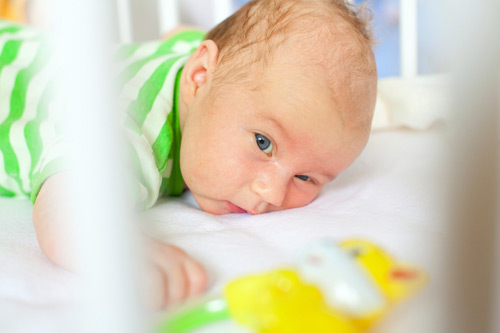Crib Safety

Protect babies' health with these need-to-know tips.
By Andrea Atkins (www.grandparents.com)
You still remember clearly putting your own babies to sleep: it was probably on their stomach in a crib decorated with matching bumpers and adorable stuffed animals. Not anymore! In the last 20 years a lot has changed about how babies are put to sleep - and the changes are not just fads - they're supported by research and meant to protect kids from dying.
"Research has shown us things we didn't know before," says Rachel Y. Moon, M.D., a pediatrician and researcher on SIDS (Sudden Infant Death Syndrome), the No. 1 killer of babies under one year of age. Moon also chairs the American Academy of Pediatrics Task Force on SIDS. Since 1992, when putting babies to sleep on their backs was recommended by the AAP, the rate of death from SIDS has dropped by 58 percent. However, the number of SIDS cases occurring when an infant is in the care of someone other than his or her parents has not decreased.
Often, grandparents say to their children, 'You slept on your stomach, and you're alive. Babies who sleep on their stomach sleep longer.' And since many grandparents are an authoritative source to their children, there can be confusion about what to do," Moon says.
But the statistics are convincing. "Very few SIDS deaths occur when babies are sleeping on their backs - and probably more than 90 percent of those that do, occur in babies who are sleeping on their stomachs."
While no one knows for sure why back sleeping is safer for babies, SIDS is a respiration problem, and Moon and others speculate that back sleeping causes babies to wake more easily. Babies who die of SIDS can't wake themselves up to breathe. Here are several other steps you should take to keep your grandchild safe:
1. Put the baby to sleep in a crib or bassinette. "People think that 'soft is safe' when it comes to babies," Moon says. "But soft is dangerous. You want them on a firm, hard surface." That means no sleeping on an adult bed or on a couch. The crib mattress should be firm, with a fitted sheet that clings tightly around it, and you should not be able fit more than two fingers between the mattress and the crib side. If you have saved your own child's crib for just this occasion, dump it. The Consumer Products Safety Commission recommends that babies not be put to sleep in any crib that is 10 years old or older since important safety changes have been made and cribs can also deteriorate.
2. Do not use crib bumpers. As cute as they are, bumpers can wind up suffocating a baby. The risk to a baby whose leg slips through a crib slat is less than to one who becomes entangled in a bumper, Moon says. Also to be avoided: Sleep-positioning bolsters, which promise to keep a sleeping baby on her side. They can also become a suffocation hazard.
3. Don't overheat the room. We tend to think that babies are colder than us, but Moon says your grandchild should be dressed in only one layer more than what you are wearing. So an extra undershirt is probably all that's needed. A great idea: sleep sacks-little one-piece garments designed to keep babies' feet and whole body warm. These sacks also negate the need for additional blankets, which the AAP says can contribute to SIDS deaths.
4. Offer a pacifier. We've been told all the reasons they're bad, but researchers speculate that pacifiers offer arousal during the night that helps the baby wake up for a few seconds.
5. Make sure babies are immunized. Encourage your children to make sure the baby's immunizations are up to date. "For babies who are fully immunized, the risk of SIDS goes down by 50 percent," Moon says. It could be because babies who die of SIDS have contracted a preventable disease whose symptoms have not yet surfaced - such as pertussis or some other illness.
6. Don't smoke in your house. Second-hand smoke is dangerous for children and may impair their airways.
 PREGNANCY
PREGNANCY  GIVING BIRTH
GIVING BIRTH  BABY CARE
BABY CARE  HEALTH & SAFETY
HEALTH & SAFETY  FUN STUFF
FUN STUFF  FAMILY
FAMILY 